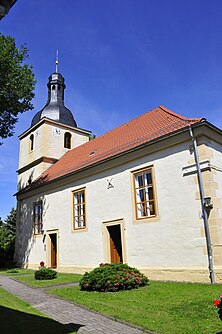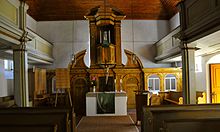Boilstädt
|
Boilstädt
City of Gotha
Coordinates: 50 ° 55 ′ 13 ″ N , 10 ° 41 ′ 6 ″ E
|
|
|---|---|
| Height : | 313 (305-315) m |
| Area : | 4.02 km² |
| Residents : | 816 (2017) |
| Population density : | 203 inhabitants / km² |
| Incorporation : | April 9, 1994 |
| Postal code : | 99867 |
| Area code : | 03621 |
|
Church of the Heavenly Gate
|
|

Boilstädt is a district of Gotha in Thuringia and is located about three kilometers south of the core city of Gotha between Boxberg and Schlossberg .
history
The first documentary mention of Boilstädts took place on March 20, 1143 under the name Boldestete . In the course of time, other names for today's Boilstädt were: Bolstedt, Bolestede, Boylstedt, Boylstat and Boulstadt. In the 19th century, the names Seefeld and Siffen were also known for the corridor surrounding Boilstädt.
The historic town center is formed by the former manor with remains of the castle (Kirchstrasse 5), the village church and the former schoolhouse (Kirchstrasse 8). The castle of the Lords of Boilstede was first mentioned in 1236. These owners were mentioned until 1483. The castle went to the Lords of Scharffenstein in 1538. After further changes of ownership, the later property was divided among the residents. The place belonged to the Tenneberg Office , which had belonged to the Duchy of Saxony-Gotha since 1640 .
Boilstädt has developed into an irregular clustered village on the Boilstädter Wasser , a stream that rises south of the locality and tributary of the Nesse . The "Boilstädter Wasser" was listed in the local chronicle of 1905 under the name "Windeborn" (Waidborn). It was used to process woad until the beginning of the 19th century . This plant has been grown in the Boilstädter district since the Middle Ages.
1709-1710 was made by Johann Andreas Tütleb a new building of the church after April 23, 1709, the existing church was demolished. In 1846 Boilstädt received the new city route with the construction of the "Langen Chaussee". The previous connection to the city of Gotha via the Kreuzchen - atonement - in the city field had served its time. With the new city route - Gothaer Straße - the community experienced its first expansion in the residential construction of the Unterdorf with the then Unterstraße. In 1878 40 hectares of community forest were sold to enlarge the Boxberg racing area .
Boilstädt belonged to the city of Gotha from October 1, 1922 to August 1, 1924 . After 25 years of self-employment in the Gotha district , Boilstädt was incorporated into Uelleben on July 1, 1950 . On April 30, 1990 it became a separate municipality again. The outskirts of the town, built in the mid-1990s, form the northern edge of the town. When Boilstädts re-incorporated into the city of Gotha on April 9, 1994, the population was 471. The total area of the district is 401 hectares today, of which 14 hectares are buildings and open spaces, 336 hectares are used for agriculture and 27 hectares are recreational and forest areas. In spring 2015, a memorial stone for Josef Ritter von Gadolla was inaugurated not far from the restaurant "Zum Wiesengrund".
Mr. von Boilstädt
In the course of road construction work between Boilstädt and Gotha- Sundhausen , a 2.40-long burial chamber from the Merovingian era was discovered in 2012 and 2013 , in which, as the first grave goods of the deceased, a male person of high class, presumably a Warrior who had been buried. The " Herr von Boilstädt " was sturdy, about 1.80 m tall and about 30 years old. The heads of the thighs show clear rider facets , which, in connection with the strongly developed muscle attachment marks of the anterior thigh muscles, suggest that the "Herr von Boilstädt" rode for a long time of his life . The grave goods included u. a. Equestrian weapons typical for this time such as javelin , spathe and sax , richly decorated bridle with a snaffle , flint and fire hammer , bronze chain and ring, comb, remains of bones from food and a fish skin. The warrior's teeth are in astonishingly good condition, which indicates a member of the upper class. Several indications suggest that the person buried here was already of Christian faith. The burial chamber was excavated as a whole block, for which steel plates were driven into the ground on four sides and tubes were pushed under the block to detach it from the ground. The entire block now weighed 17 t. The find is currently (May 2015) being examined and uncovered piece by piece under laboratory conditions at the State Office for Monument Preservation and Archeology in Weimar-Ehringsdorf . It is planned to present the find to the public in 2020 on the occasion of the state exhibition on the Thuringian Kingdom .
Recent research shows that the man was buried after natural death around AD 600. At a distance of four meters from his wooden coffin, the grave of a decapitated horse and a dog was discovered. The finds of a bronze Byzantine oil lamp and a Visigothic gold coin, which were probably struck in Spain after the Byzantine model in the time before the Visigoth king Leovigild , are also considered spectacular . The coin was placed under the body's tongue, probably as payment for the “ferryman to the afterlife”. Some grave goods (three-layer comb made of bones, a bag with a presumably Roman glass pearl necklace, etc.) clearly identify the deceased as a member of the upper class of his people. The excavation management suspects him to be a Thuringian who continued to fight for independence after the Thuringian Kingdom was broken up by the Franks (531). A second warrior grave was discovered by archaeologists in the cemetery in question. Genetic examinations should show whether there was a relationship between the two warriors.
Culture and sights
- The residential building Boilstädter Platz 1 is included in the list of cultural monuments in Gotha .
- Evangelical parish church "Zur Himmelspforte" ( Lage-> ) with artistic furnishings, the churchyard and its enclosure. The previous church was consecrated to St. Quirinus and was under the patronage of Reinhardsbrunn Monastery . It was dilapidated in 1484 and completely demolished in 1709. The current church was built immediately afterwards, and the first renovations were carried out in 1748. Another restoration took place in 1830. The choir and nave are together 18.3 m long and 8.4 m wide. The tower in the west of today's church stands on the medieval foundation walls of a wooden previous building, which was replaced by a new stone building in 1748, which is evidenced by the year under the upper arched window on the south side of the tower. Inside, the church only has a circumferential gallery, which corresponded to the numerical size of the parish. The wooden vaulted ceiling was built as a mirror vault. The organ from 1710 from the workshop of Johann Christoph Thielemann was replaced in 1850 by a new organ by Friedrich Knauf , which in turn was replaced in 1988 by an organ by Gerhard Böhm from Gotha . It has five registers , a manual and a pedal .
- The Boilstädt cemetery ( Lage-> ) has a total area of approx. 3,700 m². On it stands a natural stone with an inset for the fallen heroes of the First World War.
- Boxberg racecourse with the most traditional horse racing track in Thuringia.
- Memorial stone for Josef Ritter von Gadolla , who died on April 3, 2015 in the presence of Gadolla's niece, Helma-Doris Leinich from Graz, the district mayor of Boilstädt, Jens Wehner, and the mayor of Gotha, Knut Kreuch, near the restaurant “ Zum Wiesengrund ”was inaugurated. This is exactly where Josef Ritter von Gadolla was arrested in April 1945 and brought to Weimar. The memorial stone and the information board were made possible by private donations from the members of Gotha City Council.
traffic
You can get to Boilstädt from Gotha on Landesstraße 2146 in the direction of Uelleben . Boilstädt does not have a through road and is well connected to the transport network despite this "seclusion". The city line F drives to the district regularly.
Web links
Individual evidence
- ↑ Peter Acht (arr.): The documents since d. Death of Archbishop Adalbert I (1137) until z. Death of Archbishop Konrad (1200) . In: Historical Association for Hesse (Ed.): Mainzer Urkundenbuch . Volume II-1 (1137-1175). Darmstadt 1968. (38)
- ↑ August Beck : History of the Gothaic Land, Volume III. History of the country towns, market towns and villages, Part I. Altenbergen-Mechterstedt. Gotha 1875, p. 46f.
- ↑ August Beck : History of the Gothaic Land, Volume III. History of the country towns, market towns and villages, Part I. Altenbergen-Mechterstedt. Gotha 1875, p. 50.
- ^ The new district division of the state of Thuringia from 1922, published by the Thuringian State Statistical Office, p. 1
- ↑ V. Implementing Ordinance to the Emergency Act on the Merger of Municipalities of March 18, 1924, Collection of Laws for Thuringia No. 36 pp. 319–320
- ↑ 2. Ordinance amending the district and community boundaries in the State of Thuringia of June 26, 1950 Government Gazette for the State of Thuringia No. 18/1950, pp. 193–196
- ↑ Federal Statistical Office (Ed.): Municipalities 1994 and their changes since 01.01.1948 in the new federal states . Metzler-Poeschel, Stuttgart 1995, ISBN 3-8246-0321-7 , pp. 422 .
- ^ Press release from the City of Gotha
- ↑ Homepage Boilstädt - Uwe Ulrich: A visit to Mr. von Boilstädt
- ↑ Michael Helbing: Formerly Christ from Thuringia: News from the Lord from Boilstädt. In: Thüringer Allgemeine from February 13, 2016 p. 14 Culture in Thuringia
- ↑ General Gazette No. 20 of May 13, 2015
- ↑ General Gazette No. 7 of February 17, 2016
- ↑ List of monuments of the city of Gotha
- ↑ Wieland Fischer: Memorial stone for the Knight of Gadolla. Honor for rescuers of the city of Gotha , in: Thüringische Landeszeitung, local section Gotha, April 4, 2015.
- Paul Lehfeldt: Architectural and Art Monuments of Thuringia , 1891


